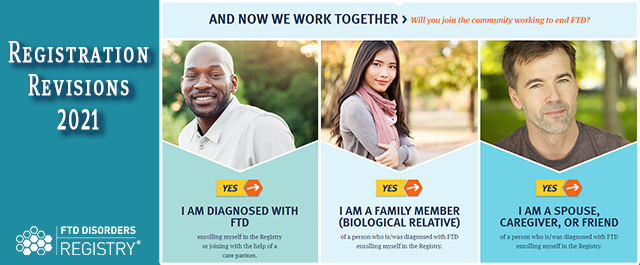PRESS & NEWS
Registry Improves Registration Process and Updates Registrant Features in 2021

Changes improve user experience and collect additional data
Changes improve user experience and collect additional data
Last month the FTD Disorders Registry launched a revised registration process to streamline the collection of data and improve participant’s experience. The change took place in February 2021 during historic weather conditions when most of the United States was covered with record-breaking cold temperatures.
“Updates to the Registry’s registration process now allows us to collect additional demographic information that will provide a more in-depth picture of the FTD community,” stated Registry Director Dianna Wheaton, Ph.D., M.S., CHES. “With the update, all persons, whether they join the Contact Registry or the Research Registry, will be able to have their voice heard.”
Prior to the changes, most demographic information was collected only from registrants who signed up to participate in research and completed all three of the Registry’s intake surveys.
The Registry did not collect full addresses nor telephone numbers, only ZIP codes and email addresses. This made it difficult to communicate with registrants when email inboxes became full or email addresses were changed or deleted.
Now the Registry collects address and phone numbers, as well as race, ethnicity, and other demographic details upfront for both Contact Registry and Research Registry enrollees.
“Tracking this additional information allows the Registry to assess our efforts toward reaching out and inclusively representing all individuals impacted by frontotemporal degeneration (FTD),” Dr. Wheaton said.
People who registered prior to these changes will be sent an email requesting that they update their information and provide this additional data.
Additional Registration changes
The Registry’s three registration categories — FTD-diagnosed person, biological family member, and spouse, caregiver, or friend — each have their own unique set of questions and data to collect, yet there are also overlapping portions. Reminders have been included within particular sections as to who the registrant is for the account being created.
Similarly, clarity was added for individuals who assist FTD-diagnosed persons to register as to when each person’s information was desired.
The sequence of collecting participant information has been modified, and additional directions and helpful tips have been inserted. This includes pop-up text bubbles with information to guide individuals as to the type of response desired for a particular form field.
“These changes have already reduced errors, which were generating incomplete registrations,” Dr. Wheaton explained. “This included last name discrepancies for female registrants.”
Homepage Updates
The Registry added a new button style to its website, which outlines text links so they appear as buttons. On the homepage, this includes the “Participant Login” in the upper-righthand corner. This change was made to assist people in finding the login and other text links more quickly.
Furthermore, a new registration category has been created for professionals working in FTD industry-related fields. They now can sign up to receive the Registry’s quarterly newsletters and other periodic news communications. This is for those in academia, biotech, government, healthcare, nonprofits, patient advocacy groups, pharmaceutical, research, trial sponsors, and other allied industries.
Existing Account Changes
Existing registrants will also notice a couple of changes when they log into their account. The first is the new Participant Login button mentioned above.
“We have made the participant Dashboard more user-friendly,” Dr. Wheaton noted. “The My Account section has been expanded so people can see more of their account information and easily update it.”
The new My Account section includes additional pages where you can:
- Change your password
- Update your personal information
- Review your research information, if you are a Research Registry participant
- Update caregiver information, if applicable
- Request a copy of your consent form, if you did not download it when you registered
These pages are accessible via buttons from the Dashboard page, on your My Account page, or by expanding the dropdown navigation by clicking on the down arrow. The survey and notifications tabs remain the same.
“We hope these changes will help more people participate,” she said, “as we continue to collaborate with the research community to advance the science and assist in finding treatments and a cure for FTD.”
Together we can find a cure for ftd
The FTD Disorders Registry is a powerful tool in the movement to create therapies and find a cure. Together we can help change the course of the disease and put an end to FTD.
Your privacy is important! We promise to protect it. We will not share your contact information.



